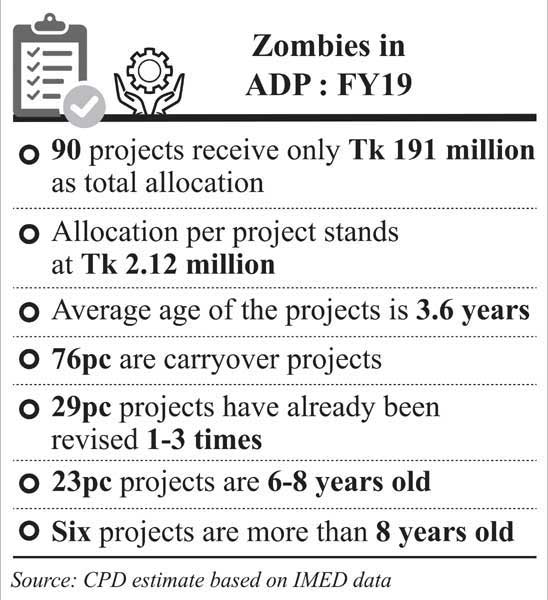Published in The Financial Express on Tuesday, 26 June 2018
 The public investment programme namely the Annual Development Programme (ADP) constitutes more than 95 per cent of development budget of Bangladesh. ADP projects are undertaken with an objective to facilitate private investment, promote economic growth, create employment opportunities and alleviate poverty. But if the desired results or benefits from a project cannot be realised in proper time, then it becomes ineffective, causes waste of scarce public resources and turns into a burden for the government. When a development project simply consumes resources and carries on for so long that it seems to be neither alive nor dead, it is called a ‘zombie’ project.
The public investment programme namely the Annual Development Programme (ADP) constitutes more than 95 per cent of development budget of Bangladesh. ADP projects are undertaken with an objective to facilitate private investment, promote economic growth, create employment opportunities and alleviate poverty. But if the desired results or benefits from a project cannot be realised in proper time, then it becomes ineffective, causes waste of scarce public resources and turns into a burden for the government. When a development project simply consumes resources and carries on for so long that it seems to be neither alive nor dead, it is called a ‘zombie’ project.
For example, ADP for the fiscal year (FY) 2018-19 hosts four projects that should have long been completed and been hanging for more than 15 years. These include: 1) ‘Establishment of 250-bed National Institute of Ophthalmology & Hospital (16 years)’, 2) ‘Upgradation of 50-bed National Institute of Cancer Research and Hospital into 300 Bed (15 years)’, 3) ‘Tannery Industrial Estate, Dhaka (15.5 years)’, and 4) ‘Construction of Third Karnaphuli Bridge (15 years)’. The average implementation rate of these four projects was about 69 per cent up to February 2018.
There are several causes for public investment projects turning into zombies. A few of those causes are inadequate or symbolic allocation, inefficiency of implementing agencies in completing projects on schedule and associated revision of project costs.
Ninety out of the 1,225 ‘investment’ projects under ADP received only Tk. 10 million (1.0 crore) or less for FY2018-19. The corresponding number of such projects were 48 and 31 in FY2017-18 and FY2016-17 respectively and has been increasing in subsequent years. As a whole, these 90 projects received only Tk. 191 million (19.1 crore) allocation in ADP for FY2018-19 (averaged Tk. 2,118 thousand or Tk 21.18 lakh or Tk 2.1 million per project). Transportation (20) and Physical Planning, Water Supply & Housing sector (21) constitute half of these projects.
Seventy-six per cent (76%) of these projects are carryover projects meaning that these projects were not completed in their initial deadline and were revised and carried forward in successive ADPs. Twenty-nine per cent (29%) of such projects have already been revised between one and three times while 16 per cent are revised but unapproved.
Due to the failure in timely implementation by respective agencies, these projects start ageing and cannot produce the expected impact or benefit for society in time. The average age of these 90 projects are 3.6 years. Twenty-three per cent (23%) of these projects are 6-8 years old while six projects are more than eight years old. Of these six projects, the ‘BSCIC Industrial Estate in Kumarkhali, Kushtia’ project with a cost of Tk. 160 million (16 crore) could achieve only 9.0 per cent financial progress in the last eight years.
These are obviously symbolic projects that are included in the ADP perhaps on political considerations. And they remain unimplemented for reasons of inadequate resource allocation. The average financial progress of the aforesaid 90 projects was about 48 per cent until February 2018. No doubt, this undermines the overall quality of ADP planning. For example, the Centre for Policy Dialogue (CPD) conducted an exercise and found that five projects including, ‘BISIC Industrial City in Kumarkhali, Kushtia (1st Revised)’, ‘Establishment of E-Payment Meter at Dhaka for Electricity under the Rural Electrification Programme (Phase-1)’, ‘Establishment of Ashuganj Internal Sea Port’, ‘Pagoda Based Pre-Primary Education’, and ‘Construction of 5-Storied Tribal Welfare Association (Central office and community hall) at Balashpur in Mymensingh,’ which had received less than Tk. 10 million (1.0 crore) in the ADP for FY2016-17, received allocation of less than Tk. 10 million (1.0 crore) in the revised ADP for FY2017-18 also. All of these five projects were scheduled to be completed within or before FY2016-17, but were carried forward more than once with only symbolic allocation, resulting in insignificant or no cumulative progress.
After inadequate financial progress and hanging for a long time with symbolic allocations, these projects are often declared as completed without being 100 per cent physically completed. Data from the Implementation Monitoring and Evaluation Division (IMED) during FY2001-FY2017 period suggest that about 65 per cent (on an average) of completed projects were stated as complete while their physical progress was not actually to the extent of 100 per cent. This raises questions about the quality of project implementation in the country. Inadequate monitoring of physical progress by implementing agencies and their line ministries (LMs), negligence in submitting project completion reports are some of the factors behind such discrepancies.
In order to utilise public resources in an efficient manner and provide the desired benefits to the citizens in timely manner, the government should abstain from creating these zombies and finish the long-standing projects on a priority basis. To this end, the Planning Commission should play an independent role and be adequately empowered to resist any political pressure during the selection of projects to be included in the ADP.
Mostafa Amir Sabbih is a Senior Research Associate at the Centre for Policy Dialogue (CPD). Views expressed in this article are of the author’s own and do not necessarily reflect those of the organisation he works for.



